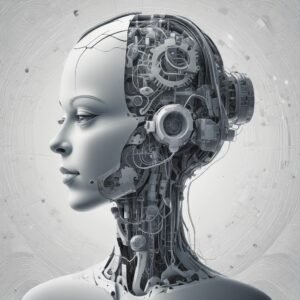Introduction to Autonomous Systems
Autonomous systems represent a significant technological leap, fundamentally changing tasks across various sectors. Unlike traditional automation, which typically relies on pre-programmed instructions and human oversight, autonomous systems are designed to operate independently. This ability is made possible through advanced technologies, including machine learning, computer vision, and sensor technologies, which empower these systems to learn from their environment and adapt to new situations.
Machine learning is at the core of autonomous systems, enabling them to analyze vast amounts of data and improve their decision-making processes over time. This adaptability is crucial in real-world applications where scenarios are often dynamic and unpredictable. For instance, in the context of autonomous vehicles, machine learning algorithms process inputs from various sensors to identify obstacles, traffic signals, and pedestrians, allowing the vehicle to navigate safely.
Another vital component of autonomous systems is computer vision, which involves the capability of machines to interpret and understand visual information from the world. This technology is essential in enabling robots and vehicles to perceive their surroundings accurately, helping them to recognize and respond to diverse elements in their environment. Moreover, sensor technologies, including LiDAR, cameras, and radar, contribute to the operational integrity of autonomous systems by providing real-time data essential for effective decision-making.
The integration of these technologies results in systems that can perform complex tasks with minimal human intervention. As industries continue to embrace these advancements, the applications of AI-driven robots and autonomous vehicles are expanding, setting the course for a transformative era in operational efficiency and productivity. Understanding the foundational concepts of autonomous systems enhances comprehension of their role in revolutionizing industries, paving the way for innovative solutions across various domains.
AI-Driven Robots in Logistics and Manufacturing
The integration of AI-driven robots in logistics and manufacturing has marked a transformative shift in these industries, enhancing operational efficiency and safety. These advanced robotic systems are programmed to automate repetitive tasks, enabling companies to streamline their operations and improve overall productivity. By leveraging artificial intelligence, these robots can perform complex operations with precision, thus reducing the likelihood of human error and optimizing workflow efficiencies.
A prime example of AI-driven robotics making significant strides in logistics is the deployment of autonomous mobile robots (AMRs). These robots are designed to navigate warehouses independently, managing the transportation of goods. Companies such as Amazon have successfully integrated AMRs into their facilities, resulting in faster inventory management and a more efficient picking and packing process. This transition not only accelerates the turnaround time for order fulfillment but also alleviates the burden of physically demanding tasks from human workers.
In manufacturing, AI-driven robots contribute to safer work environments by taking on hazardous tasks that could pose risks to human employees. Robots equipped with machine learning algorithms can predict and respond to changes in their surroundings, allowing for adaptable operations that prioritize worker safety. A notable case in point is the collaborative robots, or cobots, which work alongside human operators. These robots are particularly effective in assembly lines, where they assist in repetitive tasks while workers focus on more complex functions, thus fostering a synergistic partnership that enhances productivity.
The economic implications of AI-driven robots are profound. By automating supply chain management tasks, organizations can significantly reduce costs associated with labor and errors. These advancements not only support efficiency but also position companies to remain competitive in an ever-evolving marketplace. As AI technology continues to evolve, its importance in logistics and manufacturing is anticipated to grow, driving even greater advancements and operational improvements.
Autonomous Vehicles: Transforming Urban Mobility
The advent of autonomous vehicles represents a significant shift in urban mobility, transforming the way cities approach transportation. With the integration of advanced artificial intelligence (AI) technologies, self-driving cars have moved from theoretical concepts to practical applications. This evolution is driven primarily by the ability of AI to process vast amounts of data in real time, enabling autonomous systems to navigate complex urban environments efficiently. Algorithms designed for machine learning and computer vision allow these vehicles to perceive their surroundings, identify obstacles, and make informed decisions, enhancing their operational safety.
Smart public transport systems are also experiencing a revolution through the incorporation of autonomous technology. Buses equipped with advanced sensor suites and navigation systems can improve service frequency and reliability while decreasing operational costs. This shift not only promises to streamline urban transit but also significantly contributes to the reduction of traffic congestion and pollution, as more people opt for these efficient alternatives over personal vehicles.
However, the implementation of autonomous vehicles is not without its challenges, particularly regarding regulatory frameworks. Governments are grappling with the need to create policies that ensure public safety while encouraging innovation. Standardization of regulations across different jurisdictions is critical but remains a complex task due to varying infrastructure and urban planning needs. Moreover, public acceptance plays a crucial role; educating consumers about the safety and benefits of autonomous vehicles is essential for widespread adoption.
Ongoing pilot programs in numerous cities around the globe provide valuable insights into the operational and societal impacts of autonomous transportation. As cities experiment with these technologies, the data collected will inform future regulations and encourage collaboration between public agencies and private enterprises. The prospects for autonomous vehicles suggest a transformative potential for urban mobility, promising a safer, more efficient transportation landscape.
Future Outlook and Challenges Ahead
The advancement of AI-driven robots and autonomous vehicles holds significant promise for revolutionizing various industries. However, numerous challenges and considerations must be addressed to realize their full potential. Ethical dilemmas are among the foremost concerns; societies must grapple with the moral implications of machine autonomy and decision-making capabilities. Questions around accountability in instances of malfunction or harm arise, necessitating the development of robust ethical frameworks that govern the use of these technologies.
Societal acceptance is another critical factor influencing the future of autonomous systems. As these technologies become increasingly integrated into daily life, public perception and readiness to adapt will play a key role. Education and transparency regarding AI systems can help alleviate fears and promote understanding, encouraging a smoother transition into widespread use. Engaging communities and stakeholders in discussions about the benefits and risks of these innovations will foster a more conducive environment for their adoption.
Infrastructure development is vital in supporting the deployment of autonomous vehicles and robots. Upgrading existing infrastructure to accommodate these technologies, including smart roadways, charging stations, and advanced communication networks, will be essential for their efficient and safe operation. The synergy between AI and the Internet of Things (IoT) is expected to enhance this infrastructure, leading to more intelligent systems that improve overall functionality and user experience.
Emerging trends, such as cross-industry collaborations and research initiatives, signify a collective movement towards developing advanced robotics and autonomous systems. These partnerships can foster innovation by pooling resources and expertise, translating into groundbreaking advancements that push the boundaries of what these technologies can achieve. As we move forward, a multifaceted approach that addresses these challenges while embracing the potential of AI-driven solutions will be crucial in shaping the future landscape of industries worldwide.




